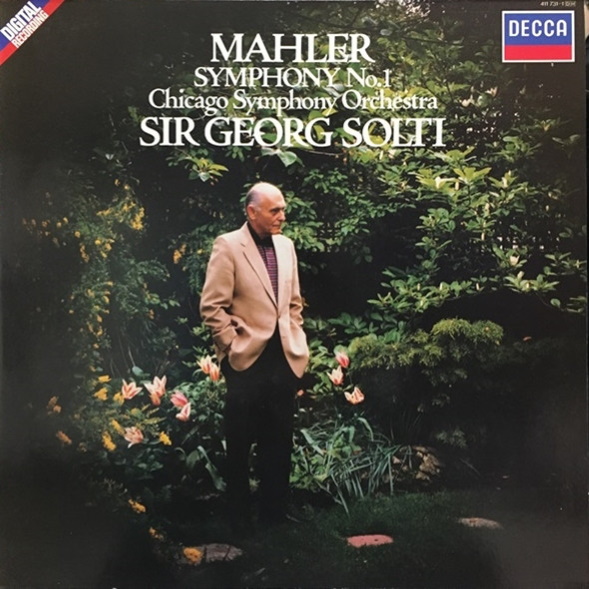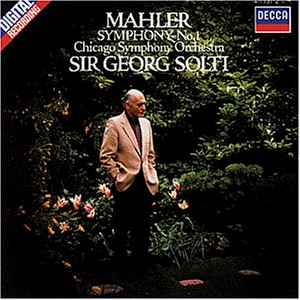 |
|
1 LP -
411 731-1 - (p) 1984
|
 |
| 1 CD -
411 731-2 - (p) 1984 |
|
| GUSTAV
MAHLER (1860-1911) |
|
|
|
|
|
|
|
Symphony No. 1 in
D Major
|
|
55' 59" |
|
- Langsam,
Schleppend · Wie Ein Naturlaut
|
15' 45" |
|
|
| - Kräftig bewegt,
doch nicht zu schnell |
7' 44" |
|
|
| - Feierlich und
gemessen, ohne zu schleppen |
11' 34" |
|
|
| -
Stürmisch bewegt |
20' 50" |
|
|
|
|
|
|
| Chicago
Symphony Orchestra |
|
| Sir
Georg SOLTI |
|
|
|
|
|
Luogo
e data di registrazione |
|
Orchestra
Hall, Chicago (USA) - ottobre 1983 |
|
|
Registrazione:
live / studio |
|
studio |
|
|
Producer |
|
James
Mallinson |
|
|
Recording
engineers |
|
James
Lock |
|
|
Prima Edizione
LP |
|
Decca
| 411 731-1 | (1 LP) | durata 55'
59" | (p) 1984 | Digitale
|
|
|
Edizione CD |
|
Decca
| 411 731-2 | (1 CD) | durata 55'
59" | (p) 1984 | DDD |
|
|
Note |
|
(c)
1984, The Decca Record Company
Limited, London
|
|
|
|
|
The startling
originality of Mahler’s
First Symphony earned him
both hostility and ridicule
when he conducted its first
performance in Budapest on
20 November 1889, reactions
which his music was to
provoke for the rest of his
life; for while his
interpretative genius as a
conductor of other people’s
music was instantly
appreciated by critics and
public alike, very few
listeners were able to see
beyond the uncomfortable
innovations of his own music
to the unique vision that
lay behind it.
It has only very recently
become clear that the
Symphony as we know it did
not reach its final form
until shortly before
publication in 1899. The
work, which Mahler had begun
as early as 1884, was
entitled ‘Symphonic Poem’ at
its Budapest premiere and
consisted then of five
movements. The original
second movement was soon
discarded (an Andante
entitled ‘Blumine’, or
‘Flower piece’,
it came to light again in
1967), and in the following
years Mahler expanded the
orchestration and revised
the work to such an extent
that hardly a bar was left
untouched. The number of
horns was increased from
four to seven and a cor
anglais and second timpanist
were added, as well as a
fifth trumpet and a fourth
trombone to reinforce the
horns in the coda of the
finale. What is significant,
however, is that apart from
the removal of the second
movement none of these
revisions affected the
musical content or structure
of the Symphony. In the ten
years between its first
performance and its final
revision for publication
Mahler had not only attained
the summit of his conducting
career (he had been
appointed Director of the
Vienna Opera in 1897) but
had also composed the Second
and Third Symphonies; his
awareness of his own
creative personality must
have grown immeasurably, and
increased experience meant
that he would now be
confident of being able to
express his musical ideas
with the most direct and
economical orchestral means.
The first movement's slow
introduction plunges us
straight into Mahler’s
unmistakable sound world as
stylized bird-calls and
distant military fanfares
gradually emerge from a
sustained A scored for
string harmonics. The impact
of such images in Mahler’s
music is constantly enhanced
by the apparently reckless
way in which he juxtaposes
them, creating immediate
tensions between our varied
reactions to different
musical styles. Thus in the
second movement a rough-hewn
peasant Ländler is
contrasted with a Trio
which, half-affectionately
and half-ironically, evokes
the sentimentality of urban
popular music. The third
movement - the greatest
cause of scandal for
Mahler’s contemporaries -
carries this mixture of
disparate elements to an
extreme as episodes of
deliberately vulgar
dance-band music (marked
‘With parody’) break into a
grotesquely-scored minor-key
canon on Frère Jacques
(or rather, its German
equivalent Bruder Martin).
The task of the finale - the
longest movement - is to
weld these elements into a
whole. The despairing F
minor material which had
briefly threatened the
spring-like freshness of the
first movement returns and
now threatens to dominate
the finale, but it is
gradually overcome as Mahler
works towards a supremely
confident D major conclusion
- a triumph of the creative
will which, in this most
remarkable of first
symphonies, gives musical
shape to the experiences
which lie at the heart of
all Mahler`s music:
nostalgia for an ideal
pastoral simplicity or for
the innocence of childhood,
a morbidly sensitive
awareness of the remoteness
and fragility of that
innocence, and the turmoil
of a passionately individual
sensibility yearning for a
self-transcending union with
the natural world.
Andrew
Huth
|
|